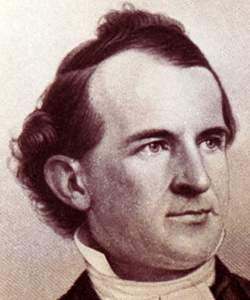George David Cummins (Dickison Chronicles)
Scholarship
George David Cummins was born near Smyrna in Kent County, Delaware on December 11, 1822, the son of George and Maria Durburow Cummins. When the younger George was just 4 years old, his father died, leaving him to be raised by his mother and uncles. He received his early education in Newark, Delaware before enrolling in Dickinson College as a member of the class of 1840 at the age of fourteen. While at the College Cummins was an active member of the Union Philosophical Society. However, in the spring of 1840 he suffered from poor health due to an enlarged heart, and was forced to withdraw from the College. After recuperating for a year, Cummins returned to Dickinson and graduated with the class of 1841 as its valedictorian.
Upon graduating, Cummins entered the Baltimore Conference of the Methodist Church but was ordained in the Episcopal Church as a deacon in 1845 and as a priest in 1847. He served parishes in Baltimore, Maryland, Norfolk, Virginia, and Washington, D.C. His skills as a preacher brought him prominence and advancement in the church. He returned to Baltimore in 1858, moved on to Chicago in 1863, and in November 1866 was consecrated as the assistant bishop of Kentucky at age 44.
His first contribution in Kentucky was to aid in the reuniting of the church following the American Civil War. This did not stop him from becoming increasingly distressed with the direction that he saw the post-war Episcopal Church taking. Perhaps remembering his Methodist roots at Dickinson and in Baltimore that had already influenced his preaching and his position on the evangelical wing of the church, he continuously clashed with his superior in Kentucky, Bishop Benjamin Bosworth Smith. He also was at odds with the notoriously anti- Evangelical Bishop Whitehouse of Illinois, who even tried to stop Cummins from preaching in his diocese. After the Convention of 1871 failed to stem what he saw as the creeping ritualism and Anglo-Catholic doctrines making their way into the Episcopal Church, Cummins had had enough. On November 10, 1873, he notified Bishop Smith that he was setting out to do God's work elsewhere, left his post in Kentucky, and removed himself to New York City. There, after meetings with other like minded clergy and laity on December 2, 1873, he organized officially what was to become the "Reformed Episcopal Church." Ten days later, he consecrated Reverend Charles Cheney of Christ Church in Chicago as the second bishop of the new church. On June 24, 1874, he was deposed formally from the Episcopal Church. Though small, his new church survived, and was incorporated also in Canada in June 1886. Today it continues to hold to the early Evangelicalism of the sixteenth century Church of England, preaching the power of Grace and the primacy of the Elizabethan Thirty-Nine Articles.
Cummins married Alexandrina Macomb of West Virginia on June 24, 1847. The couple had several children. George David Cummins died of a sudden illness in Lutherville, Maryland on June 26, 1876, three years after the founding of the new sect.
Upon graduating, Cummins entered the Baltimore Conference of the Methodist Church but was ordained in the Episcopal Church as a deacon in 1845 and as a priest in 1847. He served parishes in Baltimore, Maryland, Norfolk, Virginia, and Washington, D.C. His skills as a preacher brought him prominence and advancement in the church. He returned to Baltimore in 1858, moved on to Chicago in 1863, and in November 1866 was consecrated as the assistant bishop of Kentucky at age 44.
His first contribution in Kentucky was to aid in the reuniting of the church following the American Civil War. This did not stop him from becoming increasingly distressed with the direction that he saw the post-war Episcopal Church taking. Perhaps remembering his Methodist roots at Dickinson and in Baltimore that had already influenced his preaching and his position on the evangelical wing of the church, he continuously clashed with his superior in Kentucky, Bishop Benjamin Bosworth Smith. He also was at odds with the notoriously anti- Evangelical Bishop Whitehouse of Illinois, who even tried to stop Cummins from preaching in his diocese. After the Convention of 1871 failed to stem what he saw as the creeping ritualism and Anglo-Catholic doctrines making their way into the Episcopal Church, Cummins had had enough. On November 10, 1873, he notified Bishop Smith that he was setting out to do God's work elsewhere, left his post in Kentucky, and removed himself to New York City. There, after meetings with other like minded clergy and laity on December 2, 1873, he organized officially what was to become the "Reformed Episcopal Church." Ten days later, he consecrated Reverend Charles Cheney of Christ Church in Chicago as the second bishop of the new church. On June 24, 1874, he was deposed formally from the Episcopal Church. Though small, his new church survived, and was incorporated also in Canada in June 1886. Today it continues to hold to the early Evangelicalism of the sixteenth century Church of England, preaching the power of Grace and the primacy of the Elizabethan Thirty-Nine Articles.
Cummins married Alexandrina Macomb of West Virginia on June 24, 1847. The couple had several children. George David Cummins died of a sudden illness in Lutherville, Maryland on June 26, 1876, three years after the founding of the new sect.
John Osborne and James W. Gerencser, eds., "George Davis Cummins," Dickinson Chronicles, http://chronicles.dickinson.edu/encyclo/c/ed_cumminsGD.html.



